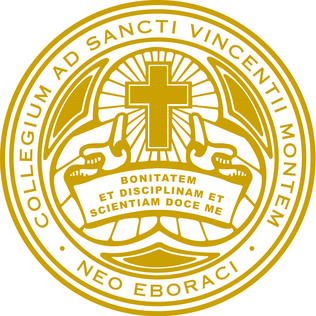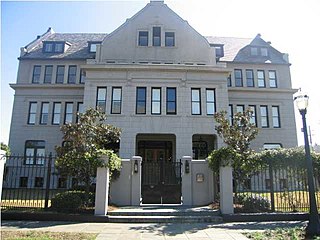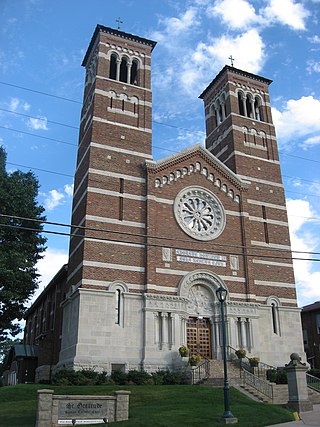
The Cathedral of Saint Paul is a Roman Catholic cathedral in the city of Saint Paul, Minnesota. It is the co-cathedral of the Archdiocese of Saint Paul and Minneapolis, along with the Basilica of Saint Mary in Minneapolis. One of the most distinctive cathedrals in the United States, it sits on Cathedral Hill overlooking downtown Saint Paul and features a distinctive copper-clad dome. It is dedicated to Paul the Apostle, who is also the namesake of the City of Saint Paul. The current building opened in 1915 as the fourth cathedral of the archdiocese to bear this name. On March 25, 2009, it was designated as the National Shrine of the Apostle Paul by the United States Conference of Catholic Bishops. It is the third-largest Catholic cathedral and sixth-largest church in the United States.

The Ursulines, also known as the Order of Saint Ursula, is an enclosed religious order of women that branched off from the Angelines, also known as the Company of Saint Ursula, in 1572. The Ursulines trace their origins to the Angeline foundress Angela Merici and likewise place themselves under the patronage of Saint Ursula. While the Ursulines took up a monastic way of life under the Rule of Saint Augustine, the Angelines operate as a secular institute. The largest group within the Ursulines is the Ursulines of the Roman Union.

The Sisters of St. Joseph, also known as the Congregation of the Sisters of St. Joseph, abbreviated CSJ or SSJ, is a Roman Catholic religious congregation of women founded in Le Puy-en-Velay, France, in 1650. This congregation, named for Saint Joseph, has approximately 14,000 members worldwide: about 7,000 in the United States; 2,000 in France; and are active in 50 other countries.
The Daughters of the Cross of Liège are religious sisters in the Catholic Church who are members of a religious congregation founded in 1833 by Marie Thérèse Haze (1782–1876). The organization's original mission is focused on caring for the needs of their society through education and nursing care.

The College of Mount Saint Vincent (CMSV) is a private Catholic college in New York City. It was founded in 1847 by the Sisters of Charity of New York.
The Sisters of St. Joseph of Carondelet (CSJ) are a Roman Catholic congregation of women religious which traces its origins to a group founded in Le Puy-en-Velay, France around 1650 by Jean Pierre Medaille, S.J. The design of the congregation was based on the spirituality of the Society of Jesus. The Sisters of St. Joseph of Carondelet became a separate congregation of pontifical right on May 16, 1877.

Mount de Sales Academy is an all-girls secondary school located in Catonsville in unincorporated Baltimore County, Maryland. The school is located near the city of Baltimore and within the Roman Catholic Archdiocese of Baltimore.

St. Peter's Church and Mount St. Joseph Convent Complex is a Roman Catholic religious and educational complex on Convent and Meadow Streets in Rutland, Vermont. The complex includes a church, rectory, two schools, a convent, and an elderly housing building. It was listed on the National Register of Historic Places in 1980. The church is an architecturally significant work of architect Patrick C. Keely.

The Cathedral of the Immaculate Conception is a Catholic Cathedral located in Camden in Camden County, New Jersey. It is the seat of the Diocese of Camden, and it was listed on the National Register of Historic Places in 2003 as the Church of the Immaculate Conception. Built in 1864, it was officially designated as a cathedral in 1937.

The Gesu Church is a historic Roman Catholic church in Miami, Florida. It is located at 118 Northeast 2nd Street. On July 18, 1974, it was added to the U.S. National Register of Historic Places. The church was built in 1896 and is the oldest Catholic Church in Miami.

The Convent of Mercy, known today as the St. Francis Place Condominiums, is a small complex of historic Roman Catholic religious buildings in Mobile, Alabama, United States. It consists of two buildings, the former convent and the former school. They were added to the National Register of Historic Places on April 24, 1992 as a part of the Historic Roman Catholic Properties in Mobile Multiple Property Submission. It, along with the Convent and Academy of the Visitation, is one of two surviving historic convent complexes in Mobile.

Derham Hall and Our Lady of Victory Chapel are administrative and religious buildings, respectively, at St. Catherine University in Saint Paul, Minnesota, United States. Derham Hall was built from 1903 to 1904 and Our Lady of Victory Chapel was constructed in 1923. The two buildings were jointly listed on the National Register of Historic Places in 1985 for their local significance in the themes of architecture, education, and religion. They were nominated for being the core buildings of Minnesota's oldest Catholic liberal arts college for women, with well-preserved collegiate architecture of their respective eras.

Saint Peter the Apostle Church is a historic Roman Catholic church at 94 Somerset Street in New Brunswick, Middlesex County, New Jersey, United States.

St. Gertrude Roman Catholic Church is a historic Roman Catholic church located at 311 Franklin Avenue in Vandergrift, Westmoreland County, Pennsylvania within the Diocese of Greensburg.

The Sibley Historic Site is the site of Henry Hastings Sibley's home, who was the regional manager of the American Fur Company and Minnesota's first governor. It is one of the 26 historical sites that are operated by the Minnesota Historical Society. Located in what is now the city of Mendota, the site consists of four limestone buildings and a large lawn area. Three of the buildings are open for touring, including a fur company cold store from 1843 and the 1840 home of fur trader and hotelier Jean-Baptiste Faribault.

St. Mary's Catholic Church is a parish of the Archdiocese of Dubuque. The church is located in Guttenberg, Iowa, United States. It is listed on the National Register of Historic Places as St. Mary's Catholic Church Historic District. In addition to the church, the historic district includes the parish rectory, convent, and school building.

St. Peter is a Roman Catholic church in Danbury, Connecticut, part of the Diocese of Bridgeport. St. Peter's was the first Catholic church built in northern Fairfield County. It is the third oldest parish, and the fifth oldest Roman Catholic Church in the Diocese of Bridgeport. St. Peter's was originally a predominantly Irish congregation. Danbury's Annual St. Patrick's Day Parade steps off in front of St. Peter's. In more recent time, the parish has a significant number of parishioners of Latino and Brazilian heritage.
St. Mary's Church, School and Convent is a historic Roman Catholic church complex off United States Route 212 in Zell, South Dakota.

The Basilica of St. Mary Star of the Sea is a Minor Basilica of the Catholic Church located in Key West, Florida, United States. It is one of the oldest Catholic parishes in the state of Florida and the oldest parish in the Archdiocese of Miami. The church is a contributing property in the Key West Historic District on the National Register of Historic Places.
The Benedictines Sisters of Elk County were a religious congregation established in Marienstadt, Pennsylvania in 1852 by three sisters from Saint Walburge Abbey in Bavaria. There they established St. Joseph Monastery, the first convent of Benedictine Sisters in North America. They opened a school for girls, St. Benedict Academy, and in 1933 expanded their apostolate into healthcare, becoming the owner and operator of Andrew Kaul Memorial Hospital in St. Marys.





















